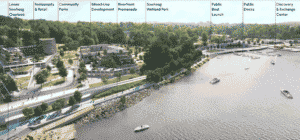
Architecture firm Cooper Robertson will propose a set of new zoning bylaws for Middletown’s 220-acre riverfront including multifamily mixed-use housing and more than 50 acres of open space and parklands. Image courtesy of Cooper Robertson
Plans for the future of Middletown’s riverfront is coming into sharp focus as architects lay out a vision for mixed-use development, recreation areas and a new connection to the city’s downtown.
Mixed-income multifamily housing, retail and restaurant space and a network of parks and promenades would be linked to Main Street by a new pedestrian bridge that hurdles the barrier formed by the construction of the Route 9 highway a half-century ago.
The city selected New York-based architects Cooper Robertson in 2021 to submit the new land-use plan, which divides the 220-acre area on the Connecticut River into four districts, each with a different set of potential uses.
“The stars are really aligning for Middletown at this moment,” said Mike Aziz, director of urban design for Cooper Robertson.
Revitalization of the riverfront has been the focus of local studies for decades, but the city now has new sources of funding that are designed to remove lingering obstacles to development. Voters in 2020 approved $55 million in bonding that includes a $5 million earmark for purchase and clean-up of a former container manufacturing plant on River Road and three residential properties on Eastern Drive. Another potential redevelopment site is the city’s decommissioned sewage treatment plant, where redevelopment plans are still in the early stages.
Cooper Robertson broke up the waterfront into four land-use districts. The Sumner Brook district that includes several municipally-owned properties, and the South End District, which was the site of a public housing complex demolished in 1999, are recommended for housing and commercial development.
The Hilltop District, which is primarily owned by the state of Connecticut, would include walking trails and a riverfront promenade. And the Riverside District would include the all-important new pedestrian bridge across Route 9, connecting directly to the downtown.
All told, about 50 acres would be reserved for parks and open space. The city of Middletown owns the entire 2-mile-long shoreline within the study area, providing an opportunity for a range of recreational uses, Aziz said. The report suggests paddle and motorboat rentals, public docks, viewing platforms, public art, a new boathouse and environmental exhibits.
Support for New Mid-rise Housing
The report’s release follows an extensive community engagement process, which gauged widespread support for the proposed changes among more than 1,200 responses, Aziz said.
“What we heard from the city and community was they want this to feel like a walkable, mixed-use extension of downtown,” he said. “To replace that character [of downtown] on the riverfront, you need to think of the 220 acres as a series of connected neighborhoods.”
Each of the districts is approximately a five-minute walk from the center to the edge, which is designed to maximize pedestrian use. New roads would include a complete streets strategy including bicycle lanes and wide tree-shaded sidewalks.
The recommended density and dimensional standards will allow the construction of mid-rise townhouses and apartments. Cooper Robertson estimates that downtown Middletown – including areas outside of the riverfront study – can absorb approximately 1,000 housing units over the next 20 years.
Cooper Robertson will submit the formal zoning amendments to the city in late 2022, Aziz said, for potential approval by the Planning and Zoning Commission. The firm also is responsible for submitting development guidelines, which include details on requirements for architectural forms and ground-floor uses.
Reuse for Sewage Plant?
City officials are studying the remediation costs for two of the former industrial properties in the study area, the former Peterson Oil property and the Jackson Corrugated Container plant, said Bobbye Knoll Peterson, Middletown’s acting director of economic and community development. The costs and clean-up requirements will determine potential future uses, such as passive or active recreation, Peterson said. Potential adaptive reuse of the treatment plant buildings also is in the early study stages.
“What stays and what goes is something that has been long talked about,” Peterson said. “Folks might think about a treatment plant as unique and some of the structures there, if we can partially reuse them, could be really interesting.”
One of the first elements of the riverfront’s reactivation is taking place even before approval of the final zoning plan for the area. Local restaurateurs Rocco and Aubrey LaMonica, who own Eli Cannon’s Tap Room in Middletown, will open a new restaurant at 80 Harbor Drive, a former restaurant property currently owned and being renovated by the city.
The renovations have been delayed by supply chain issues, delaying the hand-off to the LaMonicas’ contractor, but the new eatery could be operating by the end of the outdoor dining season, Peterson said.







